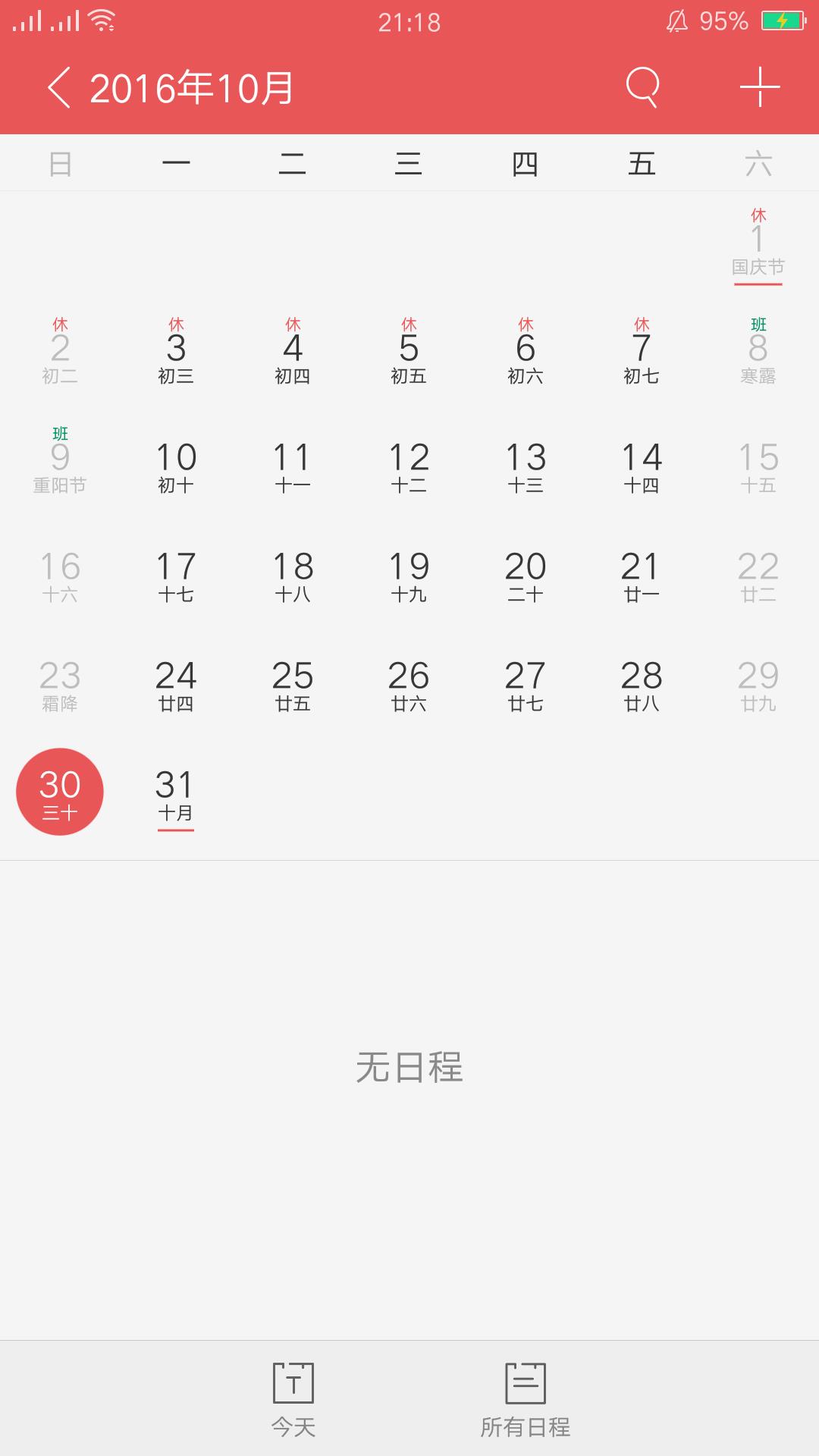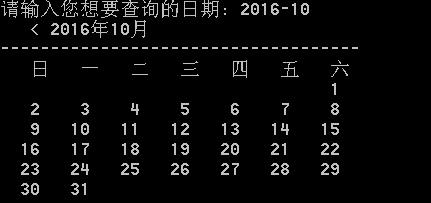Time系列四查询当月日历
Posted 千秋邈矣独留我
tags:
篇首语:本文由小常识网(cha138.com)小编为大家整理,主要介绍了Time系列四查询当月日历相关的知识,希望对你有一定的参考价值。
荒废了两个星期没学java了,今天一心想突破"日历查询"这个小程序。先用比较简单的python实现下。
无奈天资愚钝,想了一个上午。最后卡在了日期排列的问题上,只好去参考下别人的代码。
参考CSDN大牛: http://blog.csdn.net/jlshix/article/details/46970563
从简单的开始,想想既然是查询日历。打开下手机,大体是这种模样。那么我们就按照这种格式,来
设计程序吧。

首先,之前讲到的,用(%)求余符号求星期的。今天是10月30号—周日,那么如何求出若干天后是星
期几呢? 思路就是,我们把周日定为0,一天后的周一自然就是1,依此类推,周六就是六啦。那么13
天后,就是(0+13) % 7 = 5, 周五哦......
1 # coding: utf-8 2 3 print u"今天是周日!" 4 query = raw_input(">>> ") 5 6 weeks = { 7 0: u"周日", 8 1: u"周一", 9 2: u"周二", 10 3: u"周三", 11 4: u"周四", 12 5: u"周五", 13 6: u"周六", 14 } 15 16 print query + u"天后是" + weeks[(int(query) + 0) % 7]

------------------------------------------------------------------------------------------------------------------------------------------------------------
现在就利用之前做过的自动关机脚本的原理,以1970年1月1日午夜零点,也就是周四为基点。来算出从它
到现在总共过了多少秒,然后再转化为总共多少天,再算出若干天之后是星期几。
【注: 2016年10月31号是周一】
1 # coding: utf-8 2 3 import time 4 import datetime 5 #--------------------------------------------# 6 # 把当前的时间转化为指定格式 "年/月/日 时:分:秒" # 7 # 把当前时间转化为datetime.datetime的类型 # 8 # 得出从1970年元旦0点至今的总秒数 # 9 # 再将总秒数转化为总天数 # 10 #---------------------------------------------# 11 currTime = time.strftime("%Y/%m/%d %H:%M:%S") 12 dt = datetime.datetime.strptime(currTime, "%Y/%m/%d %H:%M:%S") 13 currSeconds = time.mktime(dt.timetuple()) 14 currDays = currSeconds / (3600 * 24) 15 16 weeks = { 17 0: u"周日", 18 1: u"周一", 19 2: u"周二", 20 3: u"周三", 21 4: u"周四", 22 5: u"周五", 23 6: u"周六" 24 } 25 26 print weeks[int((currDays + 4) % 7)]
--------------------------------------------------------------------------------------------------------------------------------------------------------------
其实嘛,这个小程序的难点就在于日历日期的排版上。大家可以看出来,除了第一行和最后一行,每一行都是有七个数。
所以重点就在于找出第一个数字也就是每个月的1号到底是周几。然后根据0对应周日,1对应周一等等按空格排列。从第
一个数字的空格情况上可以推断。周六的话,距离行开头有5 * 6个空格,加上开头的三个空格。(一二三这些中文分别占
两个空格,字与字之间隔三个空格。)对于1之后的其它数字,都是"4d"占有四个空格(包括其自身)的位置。所以这个开头
的三个空格是不能省略的。

1 # coding: utf-8 2 3 import time 4 import datetime 5 6 # 格式化日期: %Y表示年, %m表示月, %d表示日 7 # 注意将字符串型(string)转换成整数型(int) 8 year = int(time.strftime("%Y")) 9 month = int(time.strftime("%m")) 10 day = int(time.strftime("%d")) 11 12 #--------------------------------------------# 13 # 当前时间 # 14 # 把当前时间转化为datetime.datetime对象 # 15 # 自1970年1月1日以来到今天总共过了多少秒 # 16 # 直至今天总共过了多少天 # 17 # 直至当月的1号总共过了多少天 # 18 #--------------------------------------------# 19 currTime = time.strftime("%Y/%m/%d %H:%M:%S") 20 dt = datetime.datetime.strptime(currTime, "%Y/%m/%d %H:%M:%S") 21 totalSeconds = time.mktime(dt.timetuple()) 22 totalDays = totalSeconds / (3600 * 24) 23 start_day = int(totalDays -int(day) + 1) 24 25 index = (4 + start_day) % 7 26 27 def is_leap_year(year): 28 if year % 4 == 0 and year % 100 != 0 or year % 400 == 0: 29 return True 30 else: 31 return False 32 33 def get_num_of_days_in_month(year, month): 34 if month in (1, 3, 5, 7, 8, 10, 12): 35 return 31 36 elif month in (4, 6, 9, 11): 37 return 30 38 elif is_leap_year(year): 39 return 29 40 else: 41 return 28 42 43 def print_calender(year, month): 44 # 打印日历正文 45 # print + 逗号会多一个空格 46 print u" < %s年%s月" % (year, month) 47 print "-----------------------------------" 48 print u" 日 一 二 三 四 五 六" 49 50 for i in range(1, get_num_of_days_in_month(year, month) + 1): 51 if i == 1: 52 print " ", # 打印行首的三个空格 53 print " " * 5 * index + "%d" % 1, # 从星期几开始则空几个空格 54 else: 55 print "%4d" % i, # 宽度控制, 4 + 1 56 if (4 + start_day + i - 1) % 7 == 6: 57 print # 当日期转到周六时换行 58 59 print_calender(year, month)

上面这种是用到time 和 datetime 模块的,日期要转换为时间戳,稍显麻烦。所以下面我们用另一种直接计算天数的,
并且定义了多个函数,相信模块化的形式会更加便于理解。

1 # coding: utf-8 2 3 import time 4 5 # 将日期格式化成字符串(string), 注意转换成整数型(int) 6 year = int(time.strftime("%Y")) 7 month = int(time.strftime("%m")) 8 9 def is_leap_year(year): 10 # 判断是否闰年 11 if year % 4 == 0 and year % 100 != 0 or year % 400 == 0: 12 return True 13 else: 14 return False 15 16 def get_num_of_days_in_month(year, month): 17 # 每个月有多少天, 闰年和平年的2月(平月)分别是29和28天 18 if month in (1, 3, 5, 7, 8, 10, 12): 19 return 31 20 elif month in (4, 6, 9, 11): 21 return 30 22 elif is_leap_year(year): 23 return 29 24 else: 25 return 28 26 27 def get_total_days(year, month): 28 # 自从1970年1月1日以来过了多少天 29 days = 0 30 31 for y in range(1970, year): 32 if is_leap_year(y): 33 days += 366 34 else: 35 days += 365 36 for m in range(1, month): 37 days += get_num_of_days_in_month(year, m) 38 39 return days 40 41 def get_start_day(year, month): 42 # 返回每个月的1号是星期几 43 return (4 + get_total_days(year, month)) % 7 44 45 def print_calender(year, month): 46 # 打印日历正文 47 print u" < %s年%s月" % (year, month) 48 print "-----------------------------------" 49 print u" 日 一 二 三 四 五 六" 50 for i in range(1, get_num_of_days_in_month(year, month) + 1): 51 if i == 1: 52 print " " + " " * 5 * get_start_day(year, month) + "%d" % 1, 53 else: 54 print "%4d" % i, 55 if (get_start_day(year, month) + i - 1) % 7 == 6: 56 print 57 58 print_calender(year, month)
-------------------------------------------------------------------------------------------------------------------------------------
接下来是终极版的日历,只能查询当月的日历,实用性大打折扣。所以我们要能查到所有年份所有月份的日历,这才好玩!

1 # coding: utf-8 2 3 import re # 导入正则表达式re: (regex) 4 import time 5 6 # 输入日期, 2016/11或2016-11或2016 11的格式均可 7 # 用re.findall匹配所有数字, 并以列表的形式保存 8 date = raw_input(u"请输入您想要查询的日期: ".encode("gbk")) 9 date_list = re.findall("\\d+", date) 10 year = int(date_list[0]) 11 month = int(date_list[1]) 12 13 def is_leap_year(year): 14 # 判断是否闰年 15 if year % 4 == 0 and year % 100 != 0 or year % 400 == 0: 16 return True 17 else: 18 return False 19 20 def get_num_of_days_in_month(year, month): 21 # 返回各个月的天数 22 # 注意: 闰年和平年的2月(平月)分别是29和28天 23 if month in (1, 3, 5, 7, 8, 10, 12): 24 return 31 25 elif month in (4, 6, 9, 11): 26 return 30 27 elif is_leap_year(year): 28 return 29 29 else: 30 return 28 31 32 def get_total_days(year, month): 33 # 得出自1970年1月1日到指定日期的天数 34 total_days = 0 35 for y in range(1970, year): 36 if is_leap_year(y): 37 total_days += 366 38 else: 39 total_days += 365 40 for m in range(1, month): 41 total_days += get_num_of_days_in_month(year, m) 42 return total_days 43 44 def get_start_day(year, month): 45 # 得出每个月的1号是星期几 46 return (4 + get_total_days(year, month)) % 7 47 48 def print_calender(year, month): 49 # 打印日历正文 50 # print + 逗号会多出一个空格 51 print u" < %s年%s月" % (year, month) 52 print "------------------------------------" 53 print u" 日 一 二 三 四 五 六" 54 # 索引上限记得加1 55 for day in range(1, get_num_of_days_in_month(year, month) + 1): 56 if day == 1: 57 print " " + " " * 5 * get_start_day(year, month) + "%d" % 1, 58 else: 59 print "%4d" % day, 60 if (get_start_day(year, month) - 1 + day) % 7 == 6: 61 print 62 63 print_calender(year, month)
11月

10月

2月

--------------- 11.2号早
以上是关于Time系列四查询当月日历的主要内容,如果未能解决你的问题,请参考以下文章
